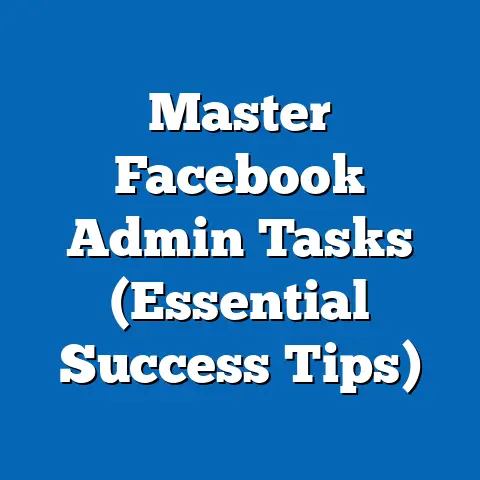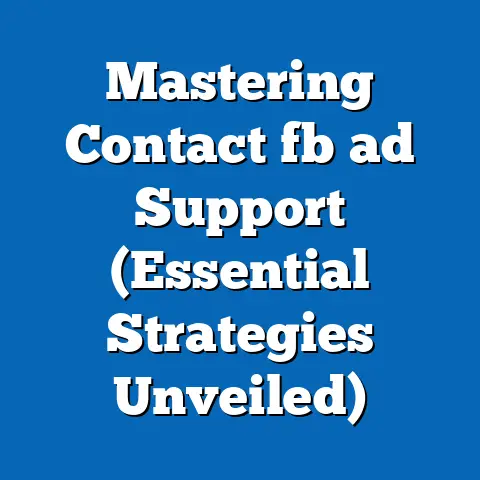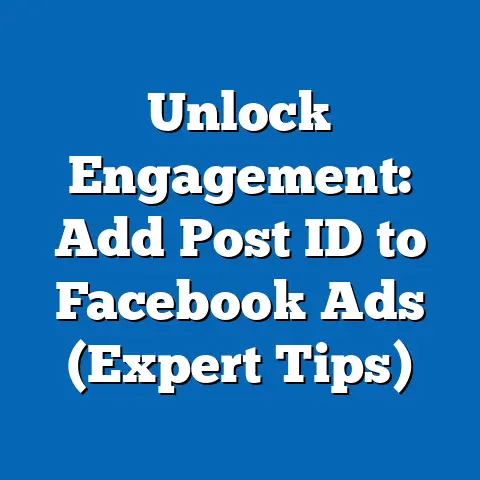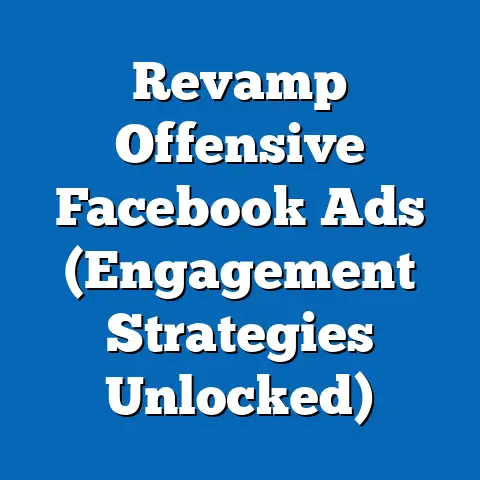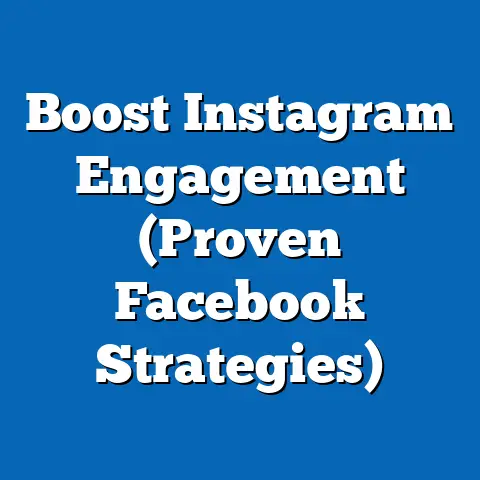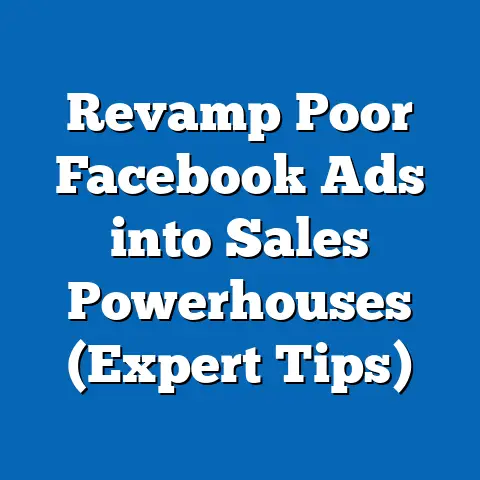Maximize Facebook Ads: Convert Leads Effortlessly (Pro Tips)
I remember when I first started dabbling in Facebook Ads, I was overwhelmed. It felt like throwing money into a black hole and hoping something would come out. But, over the years, through countless campaigns and a whole lot of learning, I’ve discovered the secrets to not just running ads, but converting those clicks into valuable leads. In today’s digital marketing landscape, Facebook Ads are a powerhouse, but only if you wield them correctly. Lead conversion is the lifeblood of any business, and mastering Facebook Ads is a critical step in turning potential customers into loyal clients.
This guide is designed to be your comprehensive resource, revealing the pro tips and strategies I’ve learned to maximize your Facebook Ads and effortlessly convert leads. From setting up your campaigns to optimizing for peak performance, I’ll walk you through every crucial step. Get ready to transform your Facebook Ads from a cost center into a lead-generating machine!
Understanding the Facebook Ads Ecosystem
The Facebook advertising platform is a beast, no doubt about it. But once you understand its inner workings, it becomes an incredibly powerful tool. It boasts billions of users, granular targeting options, and diverse ad formats, making it a prime real estate for reaching your ideal customer.
Facebook Advertising Platform: A Quick Overview
The platform is built around the Meta Business Suite, which centralizes your Facebook and Instagram business operations. Within it, the Ads Manager is your control center for creating, managing, and analyzing your campaigns.
Ad Formats: Choosing the Right Vehicle
Facebook offers a variety of ad formats, each designed to capture attention and drive specific actions:
- Image Ads: Simple and effective for showcasing products or services with a single image.
- Video Ads: Powerful for storytelling and demonstrating product features. I’ve found short, impactful videos tend to perform best.
- Carousel Ads: Allow you to display multiple images or videos in a single ad, perfect for showcasing a range of products or highlighting different features.
- Collection Ads: Designed for e-commerce, these ads feature a hero image or video followed by a selection of related products.
- Lead Ads: These are designed to capture leads directly within Facebook, making it easy for users to provide their information without leaving the platform.
- Instant Experiences (Canvas Ads): Full-screen, mobile-optimized experiences that load instantly, providing an immersive way to showcase your brand and products.
Key Metrics: Measuring What Matters
Understanding your ad performance is crucial. Here are some key metrics to keep an eye on:
- Click-Through Rate (CTR): The percentage of people who saw your ad and clicked on it. A higher CTR indicates a more engaging ad.
- Conversion Rate: The percentage of people who clicked on your ad and completed a desired action, such as filling out a form or making a purchase. This is the holy grail of metrics!
- Cost Per Click (CPC): The average amount you pay each time someone clicks on your ad.
- Cost Per Acquisition (CPA): The average amount you pay to acquire a customer.
- Return on Ad Spend (ROAS): The revenue generated for every dollar spent on advertising.
Audience Targeting: The Key to Relevance
The beauty of Facebook Ads lies in its targeting capabilities. You can target users based on:
- Demographics: Age, gender, location, education, etc.
- Interests: Hobbies, passions, and topics they’ve shown interest in.
- Behaviors: Purchase history, online activity, and device usage.
- Custom Audiences: Uploaded lists of existing customers, website visitors, or app users.
- Lookalike Audiences: Facebook finds new people who share similar characteristics to your existing customers. This is where the magic really happens!
Key Takeaway: Familiarize yourself with the Facebook Ads ecosystem, understand the different ad formats, and learn to track the metrics that matter. Targeting is the foundation of successful lead conversion, so spend time crafting your ideal audience.
Setting Up Your Facebook Ads for Success
Now that you understand the landscape, let’s dive into the practical steps of setting up your Facebook Ads for success. A solid foundation is crucial for maximizing your chances of converting leads.
Step-by-Step Guide to Setting Up Facebook Ads
- Create a Facebook Business Manager Account: This is your central hub for managing your Facebook and Instagram business assets. Go to business.facebook.com and follow the prompts to create an account.
- Set Up Your Ad Account: Within Business Manager, create an ad account. You’ll need to provide your business information and payment details.
- Install the Facebook Pixel: This is a snippet of code that you place on your website to track conversions, optimize ads, and build targeted audiences. Go to Events Manager in Business Manager to create your pixel and follow the instructions to install it on your website. I can’t stress enough how important this step is! Without the pixel, you’re flying blind.
- Define Clear Objectives: Before you start creating ads, ask yourself: What do I want to achieve? Are you looking to generate leads, drive website traffic, or increase brand awareness? Your objective will influence your ad format, targeting, and bidding strategy.
- Create Your First Campaign: In Ads Manager, click the “Create” button to start a new campaign. Choose your objective, set your budget, and define your target audience.
- Design Your Ad: Choose your ad format, upload your visuals, and write your ad copy. Make sure your ad is visually appealing, relevant to your audience, and includes a clear call-to-action.
- A/B Testing: Don’t put all your eggs in one basket! Create multiple versions of your ad with different headlines, visuals, and CTAs. Facebook will automatically show the best-performing ad to your target audience.
Defining Clear Objectives
Your advertising objective should align with your overall business goals. Here are some common objectives for lead generation:
- Lead Generation: This objective is specifically designed to collect leads directly within Facebook using Lead Ads.
- Website Traffic: Drive traffic to a landing page on your website where you can capture leads.
- Conversions: Track specific actions on your website, such as form submissions or purchases.
The Significance of A/B Testing
A/B testing (also known as split testing) is the process of comparing two versions of an ad to see which one performs better. Test different elements, such as:
- Headline: Try different headlines to see which one grabs attention.
- Visuals: Experiment with different images and videos.
- Call-to-Action: Test different CTAs, such as “Learn More,” “Sign Up,” or “Get a Quote.”
- Targeting: Refine your audience targeting to see which segments respond best.
Key Takeaway: Setting up your Facebook Ads correctly is essential for success. Install the Facebook pixel, define clear objectives, and embrace A/B testing to optimize your campaigns.
Crafting Compelling Ad Copy and Visuals
Your ad copy and visuals are the first impression your audience has of your brand. Make it count! Compelling ad copy and eye-catching visuals are the keys to grabbing attention and driving clicks. I’ve seen ads with amazing targeting fall flat because the creative was just… blah.
The Art of Persuasive Ad Copy
- Strong Headline: Your headline is the first thing people will see, so make it count. Use strong verbs, ask a question, or offer a benefit. Keep it concise and attention-grabbing.
- Engaging Body Copy: Tell a story, highlight a problem, and offer a solution. Focus on the benefits of your product or service, not just the features. Keep it concise and easy to read.
- Clear Call-to-Action (CTA): Tell people what you want them to do. Use strong, action-oriented verbs, such as “Learn More,” “Sign Up,” or “Get Started.” Make your CTA stand out visually.
Choosing Visuals That Capture Attention
- High-Quality Images and Videos: Use professional-quality visuals that are relevant to your target audience.
- Eye-Catching Design: Use bold colors, interesting fonts, and compelling graphics.
- Showcase Your Product or Service: If you’re selling a product, show it in action. If you’re offering a service, show the benefits.
- Test Different Visuals: Experiment with different images and videos to see which ones perform best.
Examples of Successful Ad Copy and Visuals
Let’s look at some examples:
-
Example 1: SaaS Company
- Headline: Stop Wasting Time on Spreadsheets. Try [Software Name] Free!
- Body Copy: Tired of manually tracking your data? [Software Name] automates your workflow and gives you real-time insights. Sign up for a free trial today!
- Visual: A screenshot of the software dashboard showing key metrics and visualizations.
-
Example 2: E-commerce Store
-
Headline: New Summer Collection is Here!
- Body Copy: Get ready for summer with our latest collection of stylish and comfortable clothing. Shop now and get 20% off your first order!
- Visual: A carousel ad featuring multiple images of models wearing the new summer collection.
-
Example 3: Local Restaurant
-
Headline: Craving Something Delicious?
- Body Copy: Join us for dinner tonight and enjoy our mouthwatering [Dish Name]. We’re offering 10% off your entire bill!
- Visual: A high-quality photo of the [Dish Name] looking absolutely irresistible.
Example 1: SaaS Company
- Headline: Stop Wasting Time on Spreadsheets. Try [Software Name] Free!
- Body Copy: Tired of manually tracking your data? [Software Name] automates your workflow and gives you real-time insights. Sign up for a free trial today!
- Visual: A screenshot of the software dashboard showing key metrics and visualizations.
-
Example 2: E-commerce Store
-
Headline: New Summer Collection is Here!
- Body Copy: Get ready for summer with our latest collection of stylish and comfortable clothing. Shop now and get 20% off your first order!
- Visual: A carousel ad featuring multiple images of models wearing the new summer collection.
-
Example 3: Local Restaurant
-
Headline: Craving Something Delicious?
- Body Copy: Join us for dinner tonight and enjoy our mouthwatering [Dish Name]. We’re offering 10% off your entire bill!
- Visual: A high-quality photo of the [Dish Name] looking absolutely irresistible.
Example 2: E-commerce Store
Headline: New Summer Collection is Here!
Example 3: Local Restaurant
Headline: Craving Something Delicious?
The Role of Consistency in Branding
- Use Consistent Branding Elements: Use the same logo, colors, and fonts across all your ads.
- Maintain a Consistent Tone of Voice: Use the same tone of voice in your ad copy and visuals.
- Create a Cohesive Brand Experience: Ensure your ads align with your overall brand messaging and values.
Key Takeaway: Crafting compelling ad copy and visuals is essential for capturing attention and driving clicks. Use strong headlines, engaging body copy, and clear CTAs. Choose high-quality visuals that are relevant to your target audience. Maintain consistency in branding across all your ads.
Targeting the Right Audience
Imagine shouting into a crowded stadium hoping someone will hear your message. That’s what advertising without proper targeting feels like – wasteful and ineffective. Targeting the right audience is paramount to maximizing your Facebook Ads for lead conversion. Without it, you’re just throwing money at the wall and hoping something sticks.
Understanding Facebook’s Targeting Options
- Demographics: Target users based on age, gender, location, education, relationship status, and other demographic factors. This is a good starting point, but don’t rely on it exclusively.
- Interests: Target users based on their interests, hobbies, and passions. This is a great way to reach people who are likely to be interested in your product or service. I’ve had success targeting niche interests related to my industry.
- Behaviors: Target users based on their online behavior, such as purchase history, website visits, and device usage. This is a powerful way to reach people who are actively looking for products or services like yours.
- Custom Audiences: Upload a list of your existing customers, website visitors, or app users to create a custom audience. This is a great way to retarget people who have already shown interest in your brand.
- Lookalike Audiences: Create a lookalike audience based on your existing customers or website visitors. Facebook will find new people who share similar characteristics to your best customers. This is a game-changer for expanding your reach.
Creating Buyer Personas
Before you start targeting, take the time to create detailed buyer personas. A buyer persona is a semi-fictional representation of your ideal customer. Include information such as:
- Demographics: Age, gender, location, income, education, etc.
- Interests: Hobbies, passions, and topics they’re interested in.
- Pain Points: What problems are they trying to solve?
- Goals: What are they trying to achieve?
- Buying Behavior: How do they research and make purchase decisions?
Pro Tips for Refining Audience Targeting
- Layer Your Targeting Options: Combine different targeting options to create a more specific audience. For example, you could target women aged 25-34 who are interested in fitness and live in New York City.
- Exclude Irrelevant Audiences: Exclude audiences that are unlikely to be interested in your product or service. For example, you could exclude people who are already customers.
- Test Different Audiences: Experiment with different audiences to see which ones perform best. Use A/B testing to compare different targeting options.
- Use Retargeting Campaigns: Retargeting campaigns are a powerful way to convert warm leads. Show ads to people who have visited your website, viewed your products, or abandoned their shopping cart.
The Benefits of Retargeting Campaigns
Retargeting campaigns are highly effective because they target people who have already shown interest in your brand. They’re more likely to convert than people who have never heard of you before. I’ve personally seen a significant increase in conversions with well-executed retargeting campaigns.
Key Takeaway: Targeting the right audience is essential for maximizing your Facebook Ads for lead conversion. Understand Facebook’s targeting options, create detailed buyer personas, and refine your targeting to improve ad relevance and conversion rates. Don’t underestimate the power of retargeting campaigns.
Optimizing Your Ads for Higher Conversions
You’ve launched your campaign, but the work doesn’t stop there! Optimizing your ads is an ongoing process that requires careful monitoring, data-driven adjustments, and a willingness to experiment. Think of it like tending a garden – you need to constantly prune, water, and fertilize to see the best results.
Monitoring Ad Performance
- Track Key Metrics: Regularly monitor your CTR, conversion rate, CPC, CPA, and ROAS.
- Use Facebook Analytics: Dive into Facebook Analytics to gain deeper insights into audience behavior, such as demographics, interests, and website activity.
- Identify High-Performing Ads: Identify the ads that are driving the most conversions and focus on optimizing them further.
- Identify Underperforming Ads: Identify the ads that are not performing well and either pause them or make adjustments.
Optimizing Ad Spend
- Reallocate Budget: Reallocate your budget to the ads that are performing best. If one ad is driving significantly more conversions than another, give it more budget.
- Adjust Bids: Adjust your bids based on performance. If you’re not getting enough impressions, increase your bid. If you’re paying too much per click, decrease your bid.
- Use Automated Bidding: Consider using Facebook’s automated bidding options, such as “Lowest Cost” or “Target CPA,” to optimize your bids automatically.
Using Facebook Analytics
Facebook Analytics provides valuable insights into audience behavior, such as:
- Demographics: Age, gender, location, education, etc.
- Interests: Hobbies, passions, and topics they’re interested in.
- Website Activity: Pages visited, time spent on site, and actions taken.
- Purchase History: Products purchased and order value.
The Significance of Landing Page Optimization
Your landing page is where the rubber meets the road. If your landing page isn’t optimized for conversions, you’re wasting your ad spend.
- Clear Headline: Use a clear and concise headline that matches your ad copy.
- Compelling Copy: Highlight the benefits of your offer and use persuasive language.
- Strong Call-to-Action: Make it easy for people to take the desired action, such as filling out a form or making a purchase.
- Mobile-Friendly Design: Ensure your landing page is mobile-friendly and loads quickly.
- A/B Testing: Test different landing page elements to see which ones perform best.
Key Takeaway: Optimizing your ads is an ongoing process that requires careful monitoring, data-driven adjustments, and a willingness to experiment. Track key metrics, use Facebook Analytics, optimize your ad spend, and ensure your landing page is optimized for conversions.
Leveraging Facebook Ad Tools and Features
Facebook provides a suite of tools and features designed to enhance ad performance and streamline ad management. Mastering these tools can give you a significant edge in your lead generation efforts. I’ve found that even a basic understanding of these tools can significantly improve campaign efficiency.
Facebook Insights
Facebook Insights provides valuable data about your audience, including their demographics, interests, and behaviors. Use this data to refine your targeting and create more relevant ads.
Ad Scheduling
Ad scheduling allows you to schedule your ads to run during specific times of the day or days of the week. This can be useful for targeting people when they’re most likely to be online and engaged. For instance, if you’re promoting a lunch special, you might schedule your ads to run during lunchtime hours.
Dynamic Ads
Dynamic ads allow you to automatically show the right products to the right people based on their past behavior on your website or app. This is a powerful way to personalize your marketing and increase conversions. For example, if someone viewed a specific product on your website, you can show them an ad featuring that product.
Automated Rules
Automated rules allow you to automate certain tasks in Ads Manager, such as pausing underperforming ads, increasing bids on high-performing ads, and sending notifications when certain events occur. This can save you time and effort and help you optimize your campaigns more effectively.
Key Takeaway: Facebook offers a variety of tools and features that can enhance ad performance and streamline ad management. Leverage Facebook Insights, ad scheduling, dynamic ads, and automated rules to maximize your lead generation efforts.
Case Studies: Success Stories of Facebook Ad Campaigns
Let’s take a look at some real-world examples of brands that have successfully maximized Facebook Ads for lead conversion. Analyzing these case studies can provide valuable insights and inspiration for your own campaigns.
Case Study 1: E-commerce Brand – Apparel
- Challenge: The brand wanted to increase online sales and acquire new customers.
- Strategy: They created a series of Facebook Ads featuring high-quality images of their clothing. They targeted users based on their interests in fashion and style. They also used retargeting campaigns to show ads to people who had visited their website or viewed their products.
- Results: They saw a 30% increase in online sales and a 20% increase in new customers.
- Key Takeaways: High-quality visuals, targeted advertising, and retargeting campaigns can be highly effective for e-commerce brands.
Case Study 2: SaaS Company – Project Management Software
- Challenge: The company wanted to generate leads and increase sign-ups for their software.
- Strategy: They created a series of Facebook Lead Ads offering a free trial of their software. They targeted users based on their job titles and interests in project management. They also used custom audiences to target people who had visited their website or downloaded their whitepapers.
- Results: They generated over 500 leads and increased sign-ups by 40%.
- Key Takeaways: Lead Ads are a great way to generate leads directly within Facebook. Targeted advertising and custom audiences can help you reach the right people.
Case Study 3: Local Restaurant
- Challenge: The restaurant wanted to increase foot traffic and attract new customers.
- Strategy: They created a series of Facebook Ads featuring mouthwatering photos of their food. They targeted users based on their location and interests in dining. They also offered a special discount to people who showed their ad to the server.
- Results: They saw a 25% increase in foot traffic and a 15% increase in new customers.
- Key Takeaways: Visual advertising, location-based targeting, and special offers can be highly effective for local businesses.
Key Takeaway: These case studies demonstrate the power of Facebook Ads for lead conversion. By understanding the challenges, strategies, and results of these campaigns, you can gain valuable insights and inspiration for your own advertising efforts.
Conclusion
We’ve covered a lot of ground in this guide, from understanding the Facebook Ads ecosystem to leveraging advanced tools and features. Remember, maximizing your Facebook Ads for lead conversion is an ongoing process that requires careful planning, execution, and optimization.
Here’s a quick recap of the key points:
- Understand the Facebook Ads ecosystem: Familiarize yourself with the platform, ad formats, and key metrics.
- Set up your Facebook Ads for success: Install the Facebook pixel, define clear objectives, and embrace A/B testing.
- Craft compelling ad copy and visuals: Use strong headlines, engaging body copy, and high-quality visuals.
- Target the right audience: Create buyer personas, refine your targeting options, and use retargeting campaigns.
- Optimize your ads for higher conversions: Monitor ad performance, optimize ad spend, and ensure your landing page is optimized for conversions.
- Leverage Facebook Ad tools and features: Use Facebook Insights, ad scheduling, dynamic ads, and automated rules.
- Learn from case studies: Analyze successful Facebook Ad campaigns to gain valuable insights and inspiration.
Now it’s time to take action! Implement these pro tips in your own campaigns and start converting leads effortlessly. The power to transform your Facebook Ads from a cost center into a lead-generating machine is in your hands. Don’t be afraid to experiment, test new strategies, and adapt to the ever-changing landscape of Facebook advertising. Your next successful campaign is just around the corner!

